










Despite bipartisan momentum, Minnesota lawmakers fail to pass housing reforms amid growing crisis
Minnesota’s severe housing shortage, estimated at more than 100,000 homes, was a constant refrain throughout the 2025 legislative session. Lawmakers from both parties introduced numerous bills designed to expand housing options across the state. Still, despite bipartisan support and vocal backing from advocates, none made it across the finish line.
At the center of the debate was the Minnesota Starter Home Act, a cornerstone of the broader “Yes to Homes” legislative agenda. The bill sought to enable more modest, entry-level homes by relaxing certain zoning regulations and reducing barriers to development.
“There’s no one who can say we don’t have a problem,” said Housing Committee Co-Chair Spencer Igo (R, Wabana Township). “The bill is getting at how we used to do things . . . it is so core to what we believe in as Minnesotans and Americans.”
The bill passed out of both the House and Senate Housing Committees with bipartisan support. However, it met resistance in the House Local Government Committee, which declined to give it a


hearing. An amended version was narrowly defeated in the Senate Local Government Committee in a 5–6 vote. Without strong backing from legislative leadership or Gov. Tim Walz, the remaining four bills in the Yes to Homes package also quietly stalled.
For housing advocates and supporters, the failure to act was frustrating.
“The Yes to Homes coalition is deeply disappointed by the failure of the Legislature to take action in 2025 to address the cost of homes in Minnesota,” said Anne Mavity and Cristen Incitti, cochairs of the coalition. “We are deeply concerned and disappointed that the status quo remains when rising housing costs demand bold action.”
Lawmakers on both sides acknowledged the urgency of the crisis. Senate Housing Chair Lindsey Port (DFL, Burnsville) warned that “the dream of homeownership is vanishing for families everywhere.” Port called for changing outdated zoning laws and land use restrictions.

Housing industry groups urge state to prioritize affordability in new energy code PAGE 4
Twin Cities builders honored with spring awards PAGE 12
First-of-its-kind Veteran Village project under construction in Eagan PAGE 14
Housing industry comes together at Gala to raise money for
The housing industry came together on April 11 at the Saint Paul RiverCentre for the 10th annual Gala hosted by the Housing First Minnesota Foundation, raising more than $500,000 to help combat homelessness across the state.
More than 500 guests gathered for the event, which featured a lush botanical theme, an elegant dinner and spirited live and silent auctions. MyTalk107’s Miss Shannan emceed the evening including the Fund-A-Need
As we move through another productive year, I’d like to take a moment to recognize some of the meaningful progress we’re making in giving back to the communities where we live and work.
Across the industry, we understand that our responsibility extends beyond delivering quality homes. Our Housing First Minnesota Foundation is actively partnering with local organizations and nonprofits to support initiatives that make a direct impact on people’s lives across the state:
Bravo Zulu House: The nation’s first allmilitary sober living home for veterans living with PTSD, the home offers trauma-informed care, peer support and a structured environment to support long-term recovery and stability.
Housing for Heroes: The 15th single-family home for veterans continues our long-standing commitment to helping our nation’s heroes transition into safe, permanent housing.
Veteran Village: A first-of-its-kind community that will provide stable, affordable housing to those who have served our country is now underway in Eagan.
Elevate Hope House: A three-bedroom home designed to serve single mothers and their children experiencing crisis has been built with the Spring Lake Park High School Construction Trades program.
These projects represent just a portion of the broader charitable work happening statewide across our industry, all aimed at addressing critical needs through practical, scalable solutions.
In parallel, we remain focused on affordability within the industry overall. The challenges in today’s market are well documented — rising costs, labor constraints and supply chain pressures remain persistent. We will continue to work with legislative leaders at every level of government to address the zoning, permitting and regulatory barriers that drive up costs and limit the availability of affordable housing. While we’ve been

Go to HousingIndustryNews.org for subscriber
Subscribe
disappointed by the lack of meaningful policy action in many areas this session, we remain encouraged by the strong coalition of industry, nonprofit and bipartisan political partners that are committed to moving this issue forward. The fight continues, and the groundwork we’ve laid puts us in a stronger position for the road ahead.
Thank you to the partners and trades teams for helping move this important work forward. Together we’re creating more opportunities for families to achieve stable, affordable housing.




Stay up to date on the latest housing news. Subscribe to our newsletter at HousingIndustryNews.org
Advertising
For advertising information, rates, editorial calendar and production specifications, contact: Sales@HousingFirstMN.org
News Tips
Have a story idea for our next issue?
Contact Laura Burt at Laura@HousingFirstMN.org or send your story to Info@HousingIndustryNews.com
Follow Us
Be a part of the growing housing movement in Minnesota. Follow us @housingindustrynews_mn facebook.com/HousingIndustryNewsMN







HERE ARE SOME OF THE LATEST QUOTES ON THE STATE OF THE INDUSTRY:
More homes alone won’t fix the affordability crisis, not unless they are priced right, so we need to better match between what’s being built and what people can afford. That means also rethinking local zoning, incentivizing smaller and more modest homes, supporting builders and expanding access to financing tools like down payment assistance.”
NADIA EVANGELOU NATIONAL ASSOCIATION OF REALTORS
Combating housing inflation requires adequately supplied housing markets. If policy makers are serious about addressing the housing shortage, the focus must be on comprehensive reform that streamlines new housing approvals and reduces regulatory price pressures.”
NICK ERICKSON HOUSING AFFORDABILITY INSTITUTE
[Minnesota] is falling behind on not taking action on these land-use and zoning issues, which are cost free. We have not seen any substantive proposals that would change the status quo, and the data tells us the status quo is not working.”
ANNE MAVITY
MINNESOTA HOUSING PARTNERSHIP
Incentives are not a viable longterm solution; they are very much a market response to challenges for homebuyers. We need moderation in interest rates but also need more starter homes. It is critical that lawmakers keep meaningful housing solutions in play.”
JAMES VAGLE HOUSING FIRST MINNESOTA
Policy uncertainty stemming in large part from the stop-and-start tariff issues has hurt builder confidence. Still, the overall actions on tariffs in recent weeks have had a negative impact on builders, as 78% reported difficulties pricing their homes recently due to uncertainty around material prices.”
ROBERT DIETZ NATIONAL ASSOCIATION OF HOME BUILDERS
Economic anxieties disrupted the start of the home shopping season. In April, many households didn’t know what was next for their jobs, investment portfolios or budgets. This kept some buyers on the sidelines, waiting for clearer economic signals before making major purchases like a home.”
KARA NG ZILLOW
MINNESOTA’S ONLY WINDOW & DOOR-DEDICATED ABC BRANCH
We’ve brought together the metro’s top window experts—120+ years of combined experience—all in one location, built exclusively for window and door pros.
Specialized Focus: Only windows. Only doors.
Streamlined Service: From takeoff to final walkthrough.
Expert Team: Brand-certified support, no hand-offs.
Built to Serve: Dedicated equipment and warehouse space.
Top Brands You Trust
Windows: Andersen • Pella • Windsor • Vinylmax • Provia & more
Doors: Therma-Tru • Provia • Bayer Built & more
Stocking: Foams, Sealants, Flashing Tapes, Interior Trim, Jambs & Shims
Contact us today to quote your next job
1170 Eagan Industrial Rd Ste 5 | Eagan, MN 651-452-1835 | MNwindows@abcsupply.com
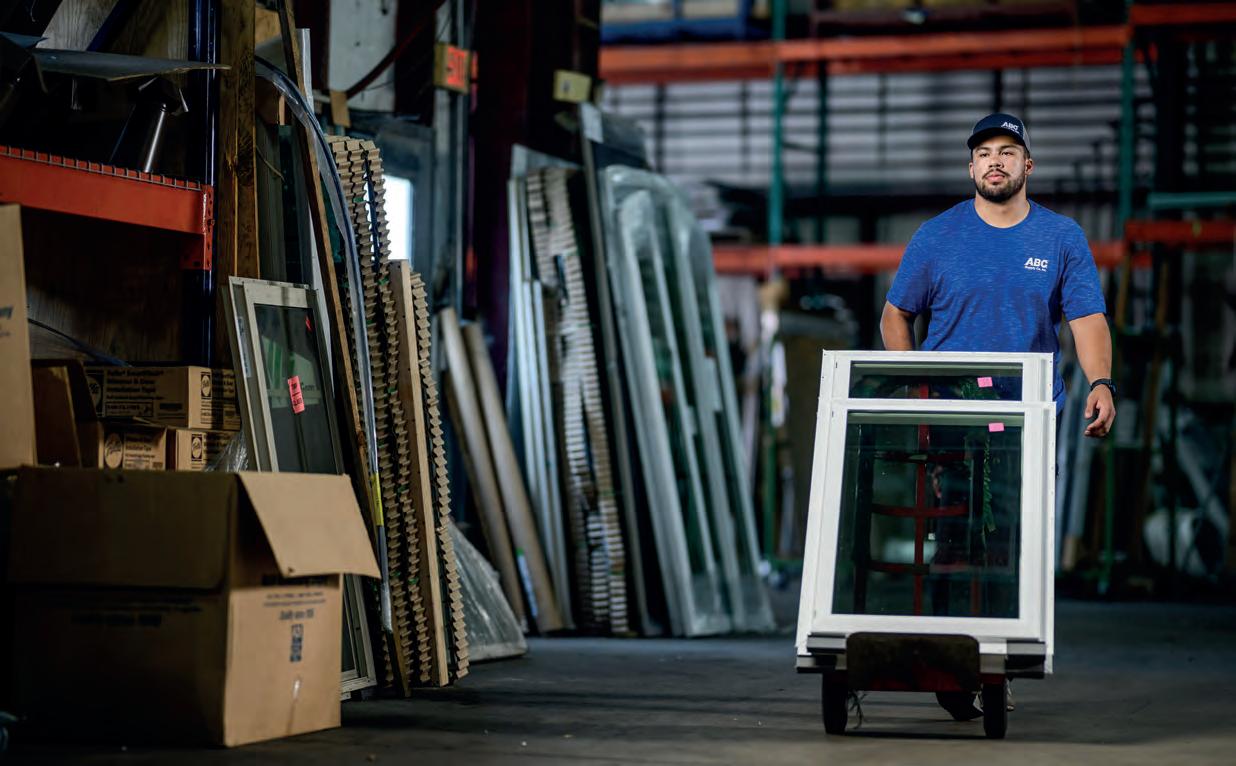
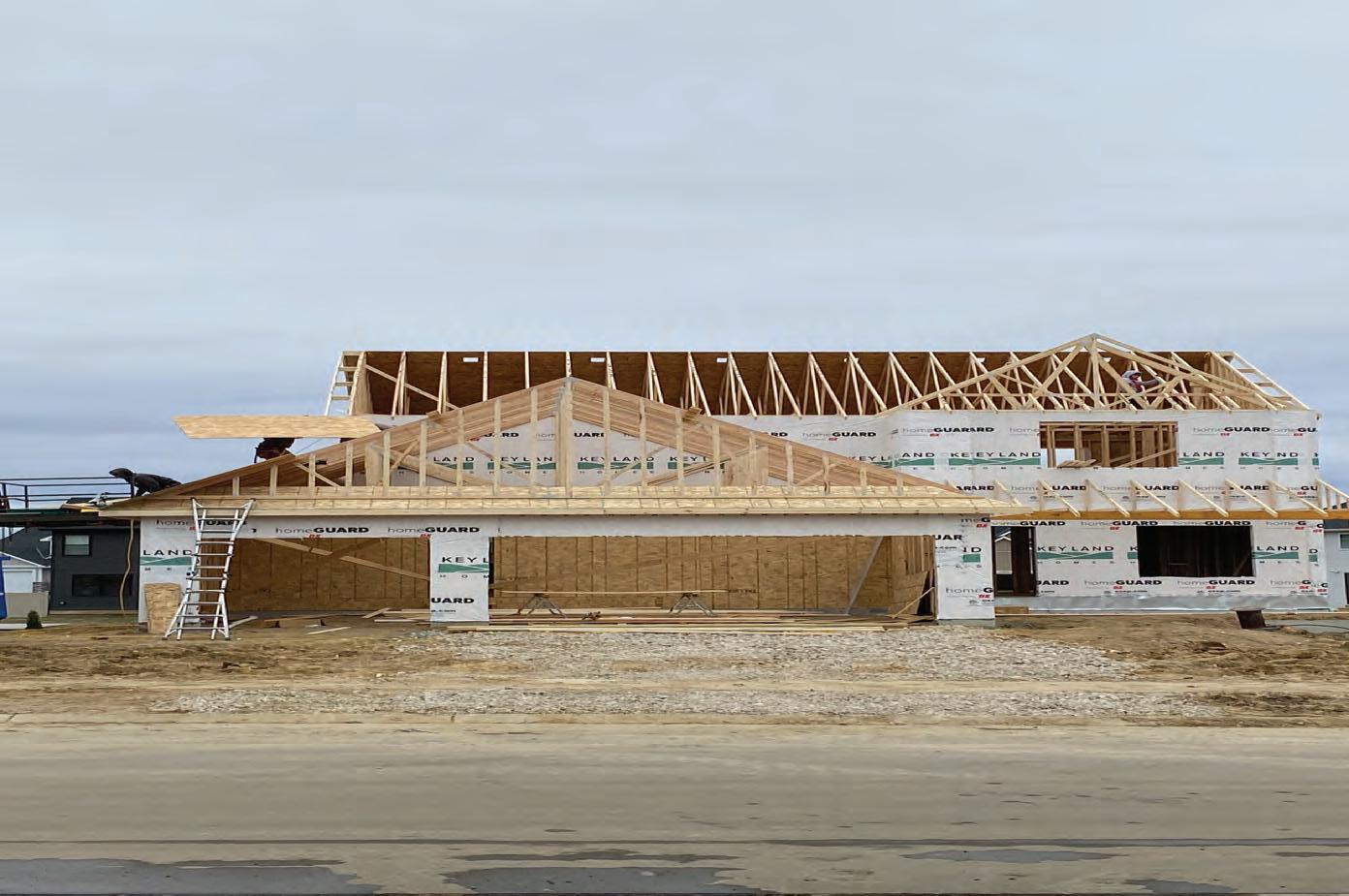
A coalition of housing and real estate organizations is calling on Minnesota regulators to preserve home affordability in the state’s forthcoming residential energy code update.
Housing First Minnesota led the coalition, submitting a formal letter in May to the Minnesota Department of Labor and Industry (DLI), urging the agency to incorporate key provisions from the 2024 International Energy Conservation Code (IECC) while protecting affordability — a statutory requirement.
The letter requested that the state retain performance path options, maintain current efficiency standards and adopt specific technical amendments, including revisions to HVAC design temperatures and rules regarding thermally isolated rooms.
Two performance-based compliance paths, the Energy Rating Index (ERI) and Simulated Performance Alternative, are widely used by Minnesota homebuilders. Eliminating them would disrupt the state’s housing market, where most new homes are currently constructed under the performance path model.
The call to action comes in response to a 2023 law passed by the Minnesota Legislature that requires the state to go beyond the IECC’s base standards. Housing advocates say the legislation removed affordability as a core consideration in the energy code; a move they argue will significantly increase construction costs. The law could raise the cost of new homes by more than $40,000 by 2038. Minnesota already has the highest new home prices in the Midwest. Combined with ongoing housing shortages and a decline in residential permits, stakeholders say the added costs would deepen the state’s housing crisis.
“Repeatedly hearing proposals that either are out of scope or fail to reach the threshold for rulemaking in Minnesota has led to hours of time lost in hearings,” the coalition wrote, emphasizing that Minnesota remains the most energy-efficient mid- to high-volume housing state in the country.
The coalition’s proposed approach aims to maintain a baseline for energy efficiency while allowing DLI to shift focus toward longterm durability standards. It also calls for enhanced training and communication between builders and code officials.
The letter was co-signed by several key industry groups, including Minnesota Realtors, the Builders Association of Minnesota, Central Minnesota Builders Association, Rochester Area Builders, Northern Minnesota Builders Association, Building Industry Association of the Red River Valley, Vikingland Builders Association and Minnesota River Builders Association.
The next version of Minnesota’s Residential Energy Code is expected to take effect in 2027.
The Minnesota Department of Labor and Industry’s Technical Advisory Groups (TAGs) are actively reviewing the 2024 International Codes and the proposed amendments with multiple groups working to finalize the updates. The Mechanical and Fuel Gas Code TAG, alongside the Structural TAG, will join the Administrative TAG in completing their review of relevant code provisions.
Progress on the Residential Code and Residential Energy Code is also underway, although work has been delayed due to the
later-than-usual availability of updated code books. Experts predict that, while the 2020 State Building Code saw only nominal cost changes, the upcoming iteration will likely result in higher costs. This is largely because Minnesota has not adopted a new energy code since the 2012 International Energy Conservation Code (IECC), which was integrated into state regulations in 2014.
Despite this lack of updates, Minnesota continues to lead the nation in energy efficiency for new construction, ranking as the highest
efficiency state in the mid- to high-production category, according to RESNET.
The state’s updated building code is expected to go into effect in 2027. Following the completion of rulemaking for the State Building Code, attention will shift to the formal rulemaking process for the Plumbing Code.
In early May, the United States House Ways and Means Committee released a draft of the budget bill. This bill contains a provision that would sunset the 45L tax credit as of
December 31, 2025, eliminating the ENERGY STAR program.
The 45L tax credit supports our nation’s goals for energy efficiency and affordable housing and is one of the most cost-effective government programs. According to ENERGY STAR, nearly $350 in energy cost savings for businesses and households have been generated for every $1 spent on ENERGY STAR over the lifetime of the program.
The bill still has several steps remaining in the legislative process and faces opposition from both sides of the aisle in both chambers.
The city of Blaine settled a lawsuit with a property owner who was denied a rezoning request to build apartments in the city, agreeing to pay $400,000 to the owner. The federal lawsuit was filed in 2023, arguing that the property owner’s equal protection rights were violated when the city denied a 196unit apartment complex near the Northtown Mall. The lawsuit argued that the city council did not have valid reasons for rejecting the project, which was protested by neighbors.
The city maintains that it did not violate the property owner’s constitutional rights, saying the decision was made in alignment with planning and zoning regulations. The
property owner originally sought $1.4 million, and the city council approved the $400,000 settlement in March.
The property owner purchased the former Rainbow Foods site in 2020, which has been vacant since 2014. The site falls within the city’s Northtown Plan, created to guide the redevelopment of the mall with a mix of property types. The owner argued that the proposed apartments fit this vision and requested that the city rezone the site from commercial to high-density residential.
The city’s planning commissions approved a conditional use permit in fall 2022, despite protests from residents that the project would
negatively impact traffic, air quality, aesthetics and crime. The city council was one vote short of passing the rezoning request, saying that the project was not consistent with the surrounding area, the building was too large and that it would increase traffic and harm the neighborhood.
An attorney for the property owner stated in a letter to the council, “The City Council’s denial was a naked byproduct of neighborhood opposition.”
After the rezoning denial, the property was sold for about $3 million. Had the apartments been approved, a purchase agreement for about $4 million had already been agreed
to with a developer. The owner sued to recover lost revenue on the property.
According to Zillow, the average rent in Blaine is $2,505, 67% higher than Minneapolis and 23% higher than Chicago. The typical home value in Blaine also exceeds both Minnesota and United States average home values.
While the city council remains split in its decision, the case highlights the growing tension between local zoning authorities and the urgent demand for more housing. As affordability challenges continue to mount, similar disputes are likely to emerge across the state.
The city of Cottage Grove made changes to its Temporary Certificate of Occupancy (TCO) policy following input from Housing First Minnesota and local builders, including concerns over seasonal deadlines and a controversial $8,000 fee.
City officials are now adjusting key components of the TCO process. TCOs issued between July 1 and October 1 will expire October 15, while those issued between October 2 and June 30 will expire July 15. The city will
evaluate which months make practical sense for as-built survey submission and create a standardized review timeline for staff to support builder scheduling needs. Finally, the city is reassessing the fee to ensure it reflects only the cost of staff time needed for processing, rather than acting as a revenue-generating measure.
These adjustments come in response to concerns raised by Housing First Minnesota and its members in a formal letter to the

city earlier this year. The group, along with local builders, argued that the original proposal, particularly the $8,000 non-refundable fee tied to seasonal TCOs, lacked statutory authority and exceeded typical permit and inspection costs in Cottage Grove.
Housing First Minnesota’s letter followed a meeting with city staff and building industry representatives, where the fee structure and its implications were discussed. The organization requested clarification from the
POWERED BY XCEL ENERGY
city on several key points, including the legal authority for implementing the fee, the methodology used to set the fee and the relationship between the fee and existing cityheld escrows for project completion.
The organization also called for further dialogue on how municipal policies could better align with efforts to ease the state’s housing affordability crisis.
A heat pump can be an efficient and environmentally friendly solution to a home’s heating and cooling needs. A heat pump is not one-sizefits-all, however. Selecting an HVAC engineer to help select the right option for the project, and perform a quality installation, is important to ensure the heat pump operates at peak efficiency.
Comparing bids from subcontractors is rarely easy. Maximizing the potential energy savings of a heat pump requires careful design and sizing, proper installation and final commissioning. When it comes to heat pump jobs, it’s important to find bids that consider the information necessary to make the project a success.
Selecting the right system requires an understanding of the home’s heat loss and heat load. For ducted heat pumps, the condition and quality of the ductwork informs the size of the heat pump system. Improved insulation, duct sealing, air filtration and heat recovery ventilation increase the cost of installation but can dictate whether the system meets the homeowner’s needs.
The subcontractor should be prepared to choose and install the right heat pump system for the specific job you’re looking to complete.
A successful heat pump installation is not the end of the process. After the pump is installed, qualified technicians test the lines for leaks and add the refrigerant to factory specifications. Once the system is up and running, the HVAC commissioning process ensures that the system is operating according to the design criteria. Customer preferences factor into system performance. HVAC installers can work with homeowners to explain the benefits of the system and help them feel comfortable with their choice. In addition, the heat pump selected may operate more efficiently with a smart thermostat. The installer may offer services to help the owner program the thermostat and take advantage of all available options.
If you are soliciting bids, you can start by visiting Xcel Energy’s list of participating installers. Qualifying Xcel Energy customers have access to rebates for heat pump installation which may influence which system is the best fit for your homebuyer. Your installer can submit the rebate application online, making it possible to save money while selecting a more efficient solution. To learn more about savings opportunities for new home builders, visit xcelenergy.com.
“If we do not make meaningful reform to land use and zoning, all the money in the world is not going to fix the problem,” said Rep. Jim Nash (R, Waconia), echoing the sentiment.
“Dollars alone will not solve our housing shortage,” added Rep. Mike Howard (DFL, Richfield). “Conservatively, if we were to solve our housing shortage just with public dollars, it would cost 35 billion dollars.”
Despite increased funding for housing in this year’s budget, legislators like Igo argued that it barely scratches the surface.
“We’re maybe going to get 1,000 homes out of what we invested today, but that isn’t even a dent at how big this problem is,” Igo said. “The elephant in the room is zoning and land use reform.”
With the session now adjourned, hopes turn to 2026. Advocates vow to return with stronger bills and an even broader coalition, while lawmakers on both sides are already crafting new proposals. Still, many fear that another year of legislative gridlock will leave more Minnesotans priced out of the housing market.
As housing prices continue to rise and supply remains constrained, the pressure is mounting. The 2026 session will be a critical test of whether political leaders are prepared to take bold action.
Recent tariffs announced by the Trump administration are impacting Minnesota’s housing landscape. Th ese trade policies, targeting imports from Canada, Mexico and China, are infl uencing construction costs, home prices and market dynamics across the state.
The newly imposed tariff s, currently 25% on imports from Canada and Mexico and 30% on Chinese goods, have led to increased costs for essential building materials like lumber, steel and aluminum. Th ese percentages remain moving targets, as tariff changes are shifting so frequently. Th e National Association of Home Builders (NAHB) estimated this surge in material prices could add $7,500 to $10,000 to the cost of constructing a single-family home.
New housing costs in Minnesota are already the highest in the region; the median price currently sits at $535,000, while Wisconsin off ers a median price of $490,000.
Th e administration has made several changes to the tariff s since their April 2 announcement. This has created uncertainty, dampening builder sentiment. In February, NAHB reported a drop in builder confidence to its lowest level in five months.
The federal tariff s are aff ecting Minnesota’s housing market by increasing construction costs, elevating home prices, and introducing economic uncertainty. Th ese factors collectively strain both builders and buyers, particularly in the aff ordable housing sector. As the state navigates these challenges, stakeholders will need to adapt strategies to mitigate the tariff s’ impact and support housing market stability.
Q & A with Mark Foster, vice president of legislative & political affairs for Housing First Minnesota
Q: What were the key housing-related bills introduced during the 2025 Minnesota legislative session and what housing-related efforts passed this session?
A: Th e most prominent housing-related legislation was the Minnesota Starter Home Act, a key component of the Yes to Homes agenda. This bill aimed to reform zoning laws to allow for more starter homes and smaller, more aff ordable housing types — directly aligned with the coalition’s focus on increasing housing supply through regulatory reform. In total, five major bills were introduced under the Yes to Homes platform, all supported by a broad coalition of more than two dozen organizations.
Despite bipartisan support, none of these bills passed. While they cleared initial hurdles in the House and Senate Housing Committees, they ultimately died in Local Government Committees or were deprioritized by leadership.
Some increased housing-related funding was included in the final state budget, but no major policy reforms were enacted to address underlying structural barriers such as zoning, land use, or permitting delays.
Q: What role did the Yes to Homes coalition play in shaping housing legislation this session, and what were the most notable wins for the coalition?
A: The Yes to Homes coalition was a central player in shaping the legislative conversation around housing. They built a diverse, bipartisan base of support and helped introduce a comprehensive suite of bills. The coalition successfully framed housing supply as a statewide crisis and positioned zoning reform as a critical tool for aff ordability.
However, the most notable “win” was not legislative, but narrative: they succeeded in making zoning reform and housing choice part of the mainstream policy debate, garnering support from both Democrats and Republicans. Th is groundwork sets the stage for future sessions.
Q: What challenges and setbacks did the coalition face?
A: The coalition’s greatest challenge was significant resistance from local government interests and local elected offi cials opposed to loosening zoning regulations — often described by legislators as “pearl-clutchers” holding back needed reform.
Additionally, we faced a lack of prioritization by leadership, particularly Gov. Walz and legislative leadership, who were unwilling to step out to support any of the desperately needed initiatives.
Internal legislative politics also played a role: despite bipartisan committee support, procedural roadblocks and intraparty disagreements kept bills from moving forward.
Q: What do you see as the biggest regulatory or legislative hurdles remaining after this session when it comes to addressing Minnesota’s housing shortage?
A: The primary hurdle remains zoning and land use regulations. There is widespread acknowledgment that current rules prevent the construction of diverse, aff ordable housing types like ADUs, duplexes and starter homes.
Additionally, local control over development decisions continues to create inconsistencies and delays. Any future legislative success will need to navigate or override these entrenched systems of yielding all authority to existing residents and forgetting about the next generation of homebuyers.
Q: How did legislators across party lines respond to the coalition’s advocacy efforts, and were there any surprising alliances or opposition?
A: There was broad, bipartisan acknowledgment of the housing crisis and support for the goals of the Yes to Homes agenda. Notably, Republicans like Rep. Spencer Igo and Rep. Jim Nash were vocal supporters of zoning reform, aligning closely with DFL members like Sen. Lindsey Port and Rep. Mike Howard on the need for structural change.
The greatest opposition came from within committees tasked with local government oversight, where skepticism about overriding local control led to procedural stalling, even in the face of bipartisan housing committee approvals.
This dynamic reveals that partisan lines were less of an obstacle than institutional conservatism around local governance and change.
Q: Looking forward, how should the industry and the Yes to Homes coalition be positioning itself to address the housing crisis?
A: To succeed in the coming months and years, the Yes to Homes coalition and housing industry should:
• Double down on public education and storytelling, making clear how zoning and regulatory barriers directly impact aff ordability and limit housing choice.
• Engage directly with local government leaders to fi nd common ground.
• Push for executive leadership — specifically, Gov. Walz’s full and public backing — so that housing becomes a session priority, not an afterthought.
• Build stronger alliances across ideological lines, especially by amplifying pro-housing voices in rural, suburban and urban districts.
• Introduce a reworked legislative package with specifi c, achievable policy reforms.
Th e 2026 session will likely be more politically charged due to the upcoming elections, which presents both risks and opportunities. Th e coalition must seize this moment to frame housing as a cross-cutting, statewide economic issue that transcends partisanship.


From premium PVC or composite decking to railing, trim, and accessories, we’ve got everything you need. Deliver beautiful, lasting outdoor spaces your customers will love.
Our dedicated deck specialists and in-house design support make it easier to find the right products, streamline selections, and keep your projects moving. Think of us as a true business partner—focused on helping you meet customer expectations, stay on schedule, and build with confidence.
DON’T WAIT TO GET THE SOLUTIONS, SAMPLES, AND SERVICE YOU NEED FOR YOUR NEXT PROJECT.
CONTACT US TODAY!





What if we had enough housing in which people could afford to live? That was the question at the heart of the 2025 St. Cloud Area Housing Summit held April 29 at St. Cloud State University, bringing together a broad set of more than 100 community stakeholders.
Central Minnesota Builder Association (CMBA) joined CentraCare, the St. Cloud Area Chamber of Commerce, United Way of Central Minnesota and St. Cloud State University in co-hosting this year’s event which was a follow-on to a similar summit CMBA helped co-host in 2023. This year’s theme was “What if: Innovative Solutions for Housing Challenges,” focusing on ways area stakeholders can engage to start moving the needle in a positive direction in terms of meeting area housing supply and affordability needs.
CentraCare president Ken Holmen kicked off the day-long summit by urging people to “think differently” in addressing housing challenges. One local city council member added, “Bring us your ideas for how you can do it, not reasons why you can’t.”
One of the day’s sessions featured CMBA members Ted Schmid of Lumber One and Greg Wensmann of Wensmann Construction providing the builder’s perspective on the costs, challenges and opportunities of building homes in which people can afford to live. Their presentation included data on the actual builder costs involved in developing a

residential lot and building a home. Schmid has done innovative affordable housing projects in the St. Cloud area and Rochester and has been engaged in local community discussions for more than a decade.
Another important session revisited St. Cloud’s Westwood Parkway development in the late 1990s which resulted in hundreds of units of affordable housing over a number of years. St. Cloud community development director, Matt Glaesman, reviewed factors
contributing to the development’s success and looked at how we might use those today. Some key ingredients to the Westwood Parkway success included visionary developers and builders, city planning and engagement, mixed-use zoning and platting, smaller single-family lot sizes and affordable project financing.
Other summit sessions highlighted the potency of Minnesota’s Housing Tax Credit, how land trusts can help provide perpetually
affordable housing, financing tools to help build and buy housing affordably, refurbishing existing home stock, local zoning opportunities and a look at modular and manufactured homes.
St. Cloud State University professor, Dr. King Banaian, and Minnesota Department of Employment and Economic Development (DEED) regional labor analyst, Luke Greiner, delivered a keynote. They shared statistics about what the area’s population would be if we had continued growing as we were prior to the 2008 recession, with perhaps 30,000 more residents living and working in the area. Having affordable places to live is key to growing an area’s workforce and economy.
The Housing Summit concluded with a look at the next steps and how participants can engage in helping bridge the housing availability and affordability gaps in the St. Cloud area. A CentraCare-facilitated community initiative in which CMBA is involved continues bringing together a broad spectrum of community stakeholders to address several factors impacting housing supply and affordability.
CMBA and the other St. Cloud Area Housing Summit planning partners are already discussing a follow-up event to help maintain momentum and provide accountability for making progress toward meeting housing needs.
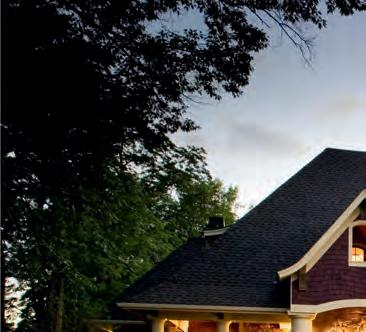






For the first time, Rochester joined Minnesota’s celebrated Parade of Homes, offering residents and prospective buyers a chance to explore seven newly constructed homes in the city. The spring tour ran March 21 to April 20, with homes open Fridays through Sundays.
The event brought Housing First Minnesota’s long-standing tradition to the Rochester community and featured homes highlighting modern design trends, energy-efficient construction and family-friendly layouts, aiming to address the city’s growing demand for diverse housing options.
“For years Rochester did not produce enough single-family homes,” said Pat Sexton, executive director of the Rochester Area Builders. “With Mayo Clinic’s announcement of their $5 billion investment, things are starting to turn. We are finally seeing the homes people need being built in large
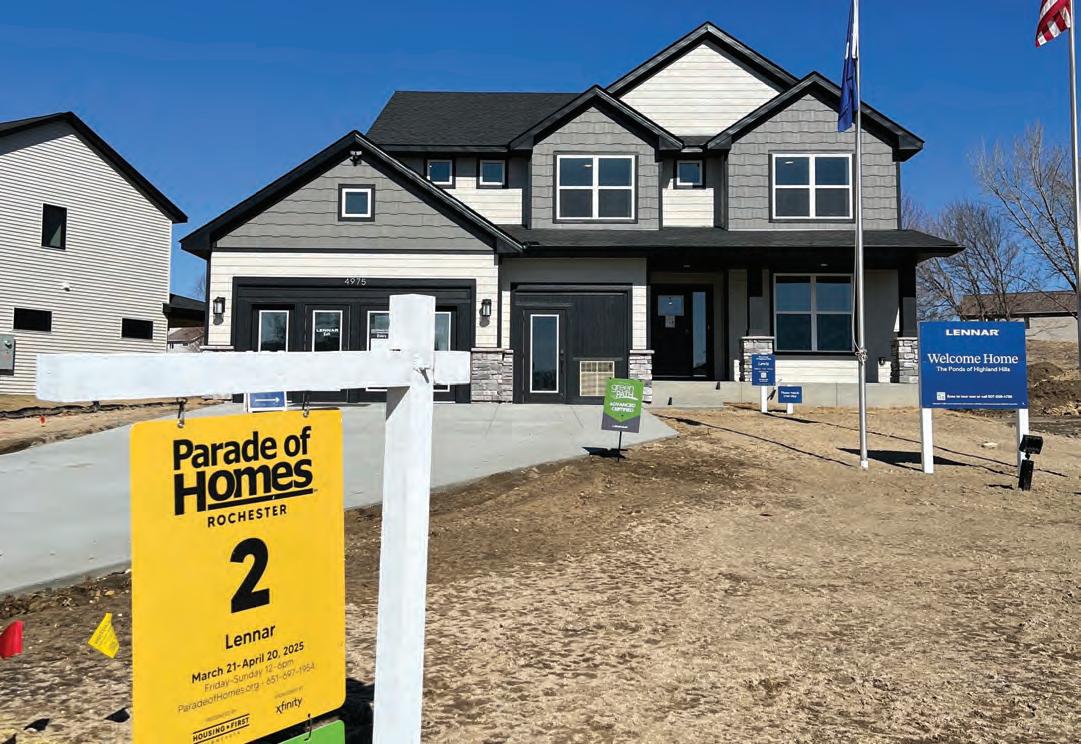
numbers. This is positive news for Rochester. Homes are a great way to build generational wealth and ensure a healthy mix of housing options our vibrant community needs.”
The tour included a First-Time

Xcel Energy’s FastApp tool helps speed up your natural gas hookup. It gives you access to dedicated professionals, costeffective designs and in-project timelines. Plus you’ll always have a single-point contact with our construction team.
For more info, visit: xcelenergy.com/Builders


Homebuyer $10K Giveaway, offering $10,000 in down payment assistance to one randomly selected qualified participant. The initiative aimed to make homeownership more accessible amid rising housing costs.



As Rochester continues to grow, events like the Parade of Homes spotlight the city’s evolving housing landscape and the efforts to meet the needs of its expanding population.








Despite economic concerns, Twin Cities homebuilders recorded a positive month of activity. Metro builders pulled 608 permits for single-family homes in April, marking a 12% growth in year-over-year activity. Multifamily construction also recorded a 17% uptick in activity compared to the previous month. According to the Keystone Report, 617 permits were issued for a total of 908 housing units during the four comparable weeks in April. SOURCE:























































































A recent regional survey highlights a challenging but nuanced outlook for the construction sector, marked by declining project backlogs, tighter competition for fewer opportunities and persistent cost pressures — despite some isolated signs of resilience.
The survey presented by The Federal Reserve Bank of Minneapolis received over 250 responses from individuals representing all areas of the construction sector across the Midwest region.
According to the survey results, approximately 58% of construction firms reported a decrease in their project backlogs over the past six months; a notable drop compared to the same period last year.
“It may indicate that many firms will be struggling to maintain a steady flow of projects,” said Erick Gracia Luna, regional outreach director for the Minneapolis Fed.
While 60% of respondents reported stable or increased project completions, a positive signal, there are growing concerns that these backlogs are not being replenished with new projects.
Compounding the challenge is the cost environment. While the pace of price increases for construction inputs has moderated since the intense spikes
of 2021–2022, costs continue to rise. Notably, respondents cited higher prices for essential materials like steel, concrete and aluminum, as well as increased shipping expenses. Additionally, wage growth, though decelerating, remains upward as companies continue to pay more to attract and retain skilled workers.
However, firms are finding it difficult to pass these rising costs onto clients. A comparatively smaller share of respondents reported increasing prices for customers, highlighting a profitability squeeze.
“Many companies are having to absorb additional costs, which can put significant pressure on their profit margins,” explained Garcia Luna.
The survey also pointed to a shift in sentiment from the previous year. In 2024, optimism about easing interest rates and improved conditions buoyed activity. In 2025, however, that optimism has cooled as many clients adopt a wait-and-see approach, delaying new projects in anticipation of more favorable financing and cost conditions later in the year.
“Despite the challenges, there’s still strong demand and opportunity,” concluded Garcia Luna. “People are committed to making it work.”



































The Spring Parade of Homes wrapped up this April, concluding five inspiring weekends of home tours across the Twin Cities metro area. The event, which ran from March 15 through April 7, featured over 350 newly constructed homes by local builders, drawing thousands of visitors eager to explore the latest in home design, technology and neighborhood development.
Hosted by Housing First Minnesota, the Spring Parade of Homes continues to be a seasonal favorite for those dreaming, designing or ready to move. The organization reported strong turnout again this year, noting particular interest in energy-efficient features, wellness-focused layouts and multifunctional spaces.
“Our builders reported strong and steady traffic throughout the tour,” said James Vagle, CEO of Housing First Minnesota. “It’s clear that interest in new homes remains high, and the tour continues to be the best way for Minnesotans to explore what’s possible in today’s housing market.”
The Fall Parade of Homes is set to return in September, promising another chance to explore the best in Minnesota homebuilding.

The Twin Cities homebuilding industry honored standout achievements of the 2025 Spring Parade of Homes, celebrating innovation, design and collaboration through Housing First Minnesota’s spring awards program.
Twelve new homes featured on the home tour were recognized with the coveted Reggie Award, a longstanding honor dating back to 1968 that highlights excellence in design, construction quality and value. In addition, 21 Trillium Awards were presented to the industry’s suppliers and trade partners for their contributions to Reggie Award-winning homes.
“These awards celebrate the talent, collaboration and commitment that drive our industry forward,” said James Vagle, CEO of Housing First Minnesota. “Each of our spring award winners demonstrates what’s possible when innovation meets craftsmanship, and we’re proud to showcase their accomplishments.”
The Reggie Awards are among the most respected accolades in Minnesota’s homebuilding community. Winners are chosen by a panel of peer professionals during the Spring Parade of Homes, a free home tour event that invites thousands of Minnesotans to explore the latest in home design and construction.
The Trillium Awards spotlight the vital behindthe-scenes role of suppliers, manufacturers and trade contractors who help bring these award-winning homes to life. Their collaboration with builders showcases the power of partnerships in delivering exceptional housing.
$300,000 TO $399,999
Price Homes
#78 | Becker
Trillium Partner: ABC Supply Co., Inc.
$400,000 TO $499,999
Caliber Homes, Inc.
#118 | Wyoming
Trillium Partner: Village Floor & Wall, Inc.
$500,000 TO $549,999
Robert Thomas
Homes, Inc.
#65 | St. Michael
Trillium Partner: LDM Electric
$550,000 TO $599,999
OneTenTen Homes, LLC
#253 | Lakeville
Trillium Partners: Crown Cabinets; MCI Paint & Drywall
$600,000 TO $699,999
OneTenTen Homes, LLC
#235 | Rosemount
Trillium Partners: Crown Cabinets; MCI Paint & Drywall
$700,000 TO $799,999
Hanson Builders, Inc.
#69 | St. Michael
Trillium Partner: Scherer Bros. Lumber Co.
$800,000 TO $899,999
Hanson Builders, Inc.
#49 | Dayton
Trillium Partners: LDM Electric; Scherer Bros. Lumber Co.
$90 0,000 TO $999,999
Robert Thomas
Homes, Inc.
#37 | Maple Grove
Trillium Partners: C&J Stoneworks, Inc.; LDM Electric
$1 MILLION UP TO $1.2 MILLION
Kootenia Homes
#195 | Woodbury
Trillium Partners: Andersen Windows; Scherer Bros. Lumber Co.
$1.2 MILLION UP TO $1.5 MILLION
Robert Thomas Homes, Inc.
#337 | Victoria
$1.5 MILLION UP TO $2 MILLION
Hanson Builders, Inc. #22 | Plymouth
Trillium Partner: Scherer Bros. Lumber Co.
$2 MILLION AND ABOVE Style & Structure
#171 | Stillwater
Trillium Partners: ABC
Supply Co., Inc.; Andersen Windows; C&J Stoneworks, Inc.

Minnesota is a nationwide leader in energy e ciency for newly built homes, according to recent data from RESNET
In 2024, Minnesota achieved the lowest average Home Energy Rating System (HERS) Index Score of any state that tested more than 4,000 homes. The HERS Index is the industry standard for measuring a home’s energy performance, with lower scores indicating higher efficiency.
The state tested 8,881 homes last year, with an average HERS Index Score of 47. By comparison, a typical resale home in the U.S. scores around 130, and a standard new home scores 100. Minnesota’s average score indicates that newly constructed homes are 53% more energy efficient than the baseline reference home and 64% more efficient than the average existing home.
Housing First Minnesota’s Green Path program, which has provided Home Performance Reports and HERS scores for more than 49,000 homes since its launch, encourages builders to go beyond minimum code requirements to deliver energy-saving benefits to homebuyers.
“Energy efficiency continues to be top of mind for many homebuyers in
Minnesota, and the homebuilding industry has once again delivered nation-leading results,” said James Vagle, CEO of Housing First Minnesota. “Minnesota’s Green Path and the HERS Index Scores allow homebuyers to have confidence in the energy efficiency of their homes.”
Currently, 58 builders across the state are recognized as Designated Green Path Builders, a designation that requires them to test at least 75% of their newly built homes each year and participate in professional development focused on sustainable building practices.
The 2025 Spring Parade of Homes highlighted the continued success of the program, with 41 homes earning Green Path Advanced Certification and one home achieving the prestigious Green Path Master Certification.
Minnesota’s strong performance underscores the growing commitment of local builders and homebuyers to energy-efficient living, reducing utility costs and environmental impact while increasing comfort and sustainability.
To celebrate Women in Construction Week and International Women’s Day, the Parade of Homes and WINC hosted a champagne toast at a stunning home on the Spring Parade of Homes. e goal was to bring women in the housing industry together to recognize their impact, celebrate their accomplishments and highlight opportunities available to women in construction.
Attendees enjoyed drinks and appetizers while mingling with fellow women in construction and touring home Style & Structure’s Dream Home featured on the spring tour.
Event Sponsors







A bold new chapter in Minnesota’s fight to end veteran homelessness began this spring, as partners from across the housing, nonprofit and faith communities kicked off Veteran Village, the state’s first dedicated multi-unit housing complex for veterans experiencing or at risk of homelessness.
Located on Rahn Road in Eagan, the $5.5 million project will feature 22 new homes and provide safe, stable shelter for up to 36 veterans and their families. This community build marks a significant milestone in a growing statewide effort to offer lasting housing solutions for those who have served.
The project is an industry-lead initiative from the Housing First Minnesota Foundation, presenting build partner Lennar, the Lennar Foundation and Minnesota Assistance Council for Veterans (MACV), in partnership with hundreds of builders, manufacturers and trade partners.
“These homes are more than just a roof and four walls. They represent safety, support, and a new beginning,” said Jessica Ryan, executive director of the Foundation. “Our organization has long believed in the power of community partnerships to create lasting impact. This project is a shining example of what’s possible when passionate people and committed organizations come together for a shared purpose.”
Veteran Village builds on years of successful partnership that has created over 39,500 square feet of veteran housing statewide since 2017. This newest effort, however, is the most ambitious to date, offering semi-permanent and permanent housing in a supportive community setting.
Construction has begun, with homes expected to be completed in phases. Once open, MACV will provide ongoing support services to help residents transition to long-term stability.



A groundbreaking initiative for veterans launched on May 28 with the grand opening of Bravo Zulu House, the first all-military sober living residence in the nation specifically designed for veterans living with post-traumatic stress disorder (PTSD).
More than 200 attendees — including veterans, community members, local officials and project partners — gathered in Winnebago, Minnesota, to mark the occasion. In honor of the milestone, Gov. Tim Walz proclaimed May 28, 2025, as Bravo Zulu House Day across the state.
Located in southern Minnesota, Bravo Zulu House provides housing for up to 13 veterans in a structured, substance-free environment. The facility offers trauma-informed care, peer support, on-site therapy, canine companionship and a hydroponic farm, all tailored to support veterans on the path to recovery.
On average, 17.6 U.S. veterans die by suicide each day, according to the the Department of Veterans Affairs.
“We knew we had to be a part of this. This wasn’t just shelter. This was innovation. This was purpose. This was a place where veterans come to rediscover themselves,” said Sofia Humphries, senior director of community impact for the Housing First Minnesota Foundation.
The project is the result of a collaborative effort

between the Foundation, APX Construction Group and several veteran advocates and health professionals. The Housing First Minnesota Foundation contributed $100,000 toward the home’s construction.
“Bravo Zulu” is a naval signal meaning “well done” — a fitting name for what organizers and attendees described as a deeply meaningful achievement. Speakers at the opening included General Joseph Votel, Congressman Brad Finstad and veterans who shared personal experiences highlighting the importance of such a facility. Tim Murray, executive director of Bravo Zulu House and Trinity Sober Homes, emphasized the project’s goal to serve as a model for veteran recovery nationwide.
Walz called the project “a beacon of hope for veterans nationwide,” underscoring the need for housing models that address the unique mental health and recovery needs of military service members.
The event also served as a call to action for broader adoption of similar programs. Advocates emphasized that veteran-specific sober housing is not only possible, but essential.
As veterans begin moving into Bravo Zulu House, organizers hope the project will serve as a national model for how to combine community collaboration with compassionate care.









A meaningful step toward ending veteran homelessness in Minnesota was taken this spring as the Housing First Minnesota Foundation, Lennar and the Minnesota Assistance Council for Veterans (MACV) broke ground on their latest single-family Housing for Heroes project in St. Paul.
Located on Cottage Avenue E., this build marks the 15th collaboration between the three partners, all committed to providing safe and stable housing for veterans
experiencing homelessness. The project includes a three-bedroom home and an accessory dwelling unit (ADU) in the backyard, designed to offer transitional housing to veterans in need.
“Upon completion of all 2025 Housing for Heroes projects, we are hopeful that we will be able to declare an effective end to veteran homelessness statewide,” said Sofia Humphries, senior director of community impact for the Foundation, at the event. “This
Dozens of industry and community members gathered on June 2 at a floor signing event to celebrate progress on the 2025 St. Jude Showcase Dream Home, a featured entry in this fall’s Parade of Homes. Hosted at the nearly completed home built by Hanson Builders, the event marked a meaningful moment in the project’s journey, offering an opportunity to recognize the many hands and hearts behind the effort.
Attendees were invited to sign the subfloor of the home, leaving behind
handwritten messages of hope and gratitude. The event served as both a celebration and a tribute to the numerous trade professionals, suppliers and organizations who donated their time, talent and resources to support the cause.
The proceeds from the sale of the St. Jude Dream Home will support St. Jude’s mission that no family ever receives a bill for treatment, travel, housing, or food.
Visitors will be able to tour the completed home during the Fall Parade of Homes.
incredible partnership has done so much to impact veteran homelessness in the state of Minnesota, and we aren’t stopping.”
The Housing for Heroes initiative brings together builders and service organizations to create dignified, transitional housing for veterans. Lennar, the homebuilder for the project, once again joins the effort to bring their expertise to this cause, while MACV will provide wraparound services to support
the residents as they transition to permanent housing.
With a shared commitment to housing stability, the partnership aims to see the effective end of veteran homelessness in Minnesota, a mission that continues to gain ground with each home completed.
Construction began following the groundbreaking, with the home set to welcome its first residents in the coming months.
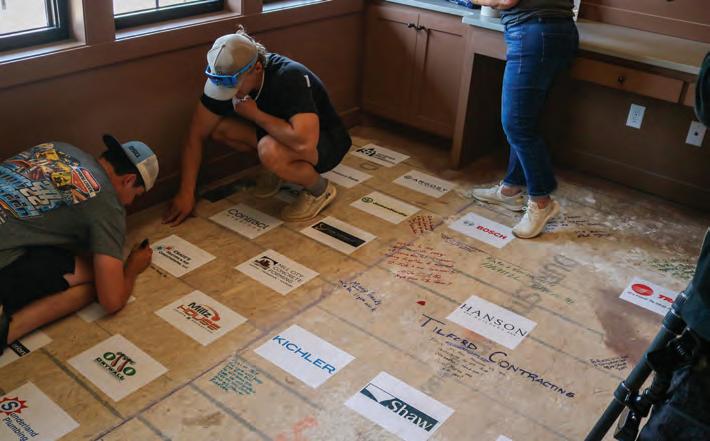
A new chapter of hope has taken root in Ham Lake, as the Housing First Minnesota Foundation proudly announced that Elevate Hope House, a three-bedroom home designed to serve single mothers and their children experiencing crisis, was moved to its permanant home site.
The project, which began in early 2024, was a collaborative effort that brought together members of the Housing First Minnesota association, Foundation committee members, and staff and students from the Spring Lake Park High School Construction Trades program. In fall 2024, Lennar joined the initiative, lending its expertise to help develop the land where the home would eventually be placed.
The house itself was constructed off-site over the course of several months before being moved to its permanent location in Ham Lake in early May. Final on-site preparations are currently underway, and a ribbon-cutting ceremony is scheduled for mid-summer to mark the home’s official opening.
“Building this house [was] important because it’s going to help a family get back on their feet after they’ve had some rough times,” shared Caleb Rodenborg, a student in the Spring Lake Park Construction Trades program. “The house also gives us students an opportunity to experience all the trades that go into building a house, and we get experience actually doing it.”
Elevate Hope House represents a model of collaboration in action, with contributions ranging from financial donations and inkind materials to hands-on construction experience provided by the students.
The project is part of the Foundation’s broader mission to provide safe, dignified housing for those in need all across the state.
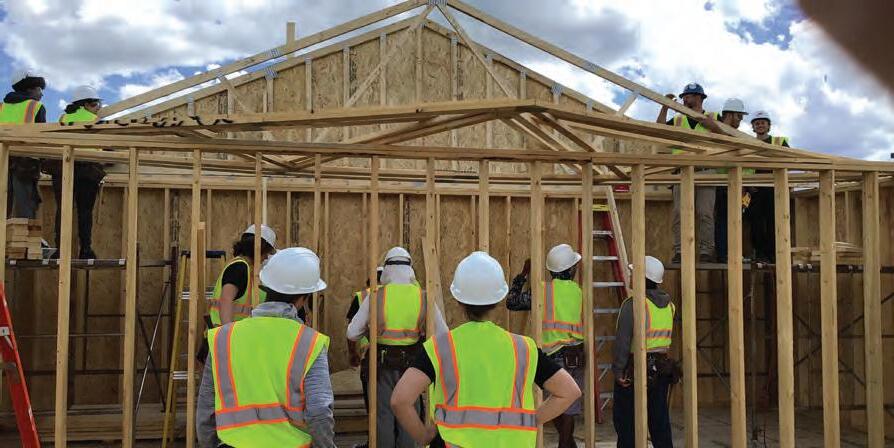



segment, which alone generated $236,000 in donations. Combined with auction proceeds totaling approximately $70,000, the gala marked a record-breaking fundraising effort for the Foundation.
“This annual event showcases the generosity and commitment
of our industry to support Minnesotans in need,” said Jessica Ryan, executive director of the Foundation. “It’s a night where we not only raise critical funds but also celebrate the partnerships that make our mission possible.”
Throughout the evening, the Foundation honored individuals and organizations that have made a significant impact. L ennar was named Build Partner of the Year, while Pulte Homes of Minnesota and Jim Fuschetto of Lyman Lumber received the Hearts in Housing Award. Contract Interiors and longtime supporters Bill and Ann Burgess were presented with the Distinguished Service Award.
The program also offered attendees a glimpse into the Foundation’s latest initiatives, including progress on Veteran Village, the Foundation’s largest supportive housing project to date. The development aims to provide stable housing and resources for veterans experiencing homelessness.
Proceeds from the Gala will support the Foundation’s continued work in building and renovating transitional and permanent housing for Minnesotans facing homelessness.
To learn more about the Housing First Minnesota Foundation and how to get involved, visit housingfirstmnfoundation.org.

A complete project management platform for homebuilders has not been available – until now. From sales & design to material procurement and paying invoices, myBLDR.com has you covered.
• All the tools you need in one solution
• Streamline design and sales processes
• Integrated 3D homebuyer selections
• 24/7 access to bids, orders and deliveries
• Control project timelines and budgets
• View and pay invoices
Scan QR Code to get started

38,000 MN construction workers covered 97% Member retention rate

$51M+ of dividends distributed to our Members
8,000 Member employees provided with safety training
$180,000 in sponsorships to MN trade associations
Did you know The Builders Group provides workers’ comp insurance to nearly 30% of Minnesota construction workers? So, who is The Builders Group?
OUR BACKSTORY IS ROOTED IN THE MINNESOTA TRADES
In 1997, a community of Minnesota construction companies decided to do something about the high cost of workers’ comp insurance in the industry. The plan was simple: join together to create a self-insured workers’ comp fund focusing exclusively on the Minnesota construction industry. A better solution created by the trades, for the trades. Today we insure nearly 30% of the Minnesota construction labor force: over 38,000 workers!
$360,000 donated by the TBG Education Foundation
TBG’s safety services success stories rarely get told because success is the job site injury that doesn’t happen. In 2023 our team provided safety training to nearly 8,000 Minnesota construction workers, both at the job site and in our state-of-the-art training facility in Eagan. In 2025, we will be growing those training capabilities by expanding the training space in our building to accommodate 170 attendees, and the addition of a custom-equipped van than can bring safety training to our members.
We have distributed over $51M in dividends to our Members, including $8.5M of dividends distributed in May of 2025. Like many in the industry, we encountered some financial headwinds in the Great Recession but pulled through it with a renewed conviction and understanding of where we needed to be financially. For example, in 2017 we expanded our coverage footprint by offering a cross-border policy for our members who have employees who work outside of Minnesota.
The labor market in Minnesota is as tight as it has ever been. TBG Education Foundation’s mission is to help close that gap. In 2024 TBG Education Foundation donated over $63,000 as part of its Tools for Schools program which helps fund school and community trades-based programming. In addition, $39,000 was given to Minnesota trade associations in matching funds for scholarships that enable more young people to get the education/training they need to start a career. A job in the trades can lead to a great career, and TBG Education Foundation is doing its part to make sure young people are exposed to that path.
Our 97% member retention rate proves that The Builders Group is a partner, not a commodity. Give your insurance agent a call and find out what being part of The Builders Group looks like for your company.
Construction begins on United Village near Allianz Field
Construction has commenced on the long-anticipated United Village project adjacent to Allianz Field, home of Minnesota United FC. The development includes a 158room hotel, two restaurant pavilions, an office building, and a 4,000-square-foot community hall. Developer Bill McGuire, who is also Minnesota United FC’s owner, also teased a long-term plan for a 3,500-seat music venue. This project aims to revitalize the Midway neighborhood, which has faced challenges related to crime and economic downturns, especially since the pandemic. The restaurants are expected to open by early 2026, and the hotel and office building by early 2027.

Office-to-housing conversions in Minneapolis and St. Paul
In response to the housing shortage and the decline in office space demand post-pandemic, Twin Cities developer Sherman Associates is converting vacant office buildings into residential units. Notably, the Landmark Towers in St. Paul and Northstar Center in Minneapolis are being transformed into approximately 400 housing units. This $185 million initiative emphasizes sustainability and job creation, as conversions are labor-intensive and utilize existing structures, reducing the need for new materials. “We need more housing of every type in every corner of the state,” said Anne Mavity, executive director of the Minnesota Housing Partnership. “What we’re looking for are ways to creatively and innovatively leverage what’s available to us to create that housing.”
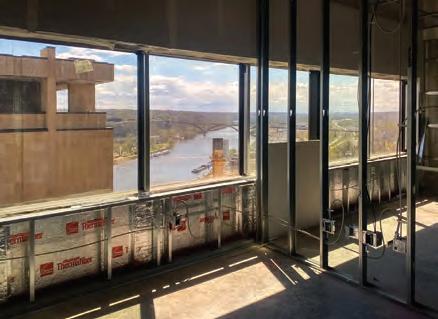
Rent control amendment hopes to bring development back to St. Paul
The St. Paul City Council voted 4-3 to exempt buildings constructed after 2004 from the city’s rent control ordinance, a move applauded by developers who say the policy had deterred investment and stalled major housing projects. The rent control law, enacted in 2022, capped annual rent increases at 3%. Supporters of the amendment, including developers behind projects like Highland Bridge and The Heights, argue the change will revive construction activity and bring thousands of new homes — including affordable units — to a city facing a significant housing shortage.
City officials and labor representatives echoed concerns about stagnating development, warning that rent control had caused a drop in building permits and financing for new housing.
Kim Nelson, deputy political director for the North Central States Regional Council of Carpenters, said rent stabilization “has discouraged housing supply . . . Yet we know increasing housing supply is a key factor to keeping rents low and housing affordable.”
The narrow vote highlights the ongoing tension between protecting renters and encouraging investment to meet St. Paul’s pressing housing needs.


When it comes to windows and doors, no one does it better than the team at Lampert Lumber. With decades of experience, our specialists provide expert guidance to help you find solutions for even the most complex projects. We offer a broad selection of styles, materials, colors, and sizes to achieve the look your customers want. As a trusted supplier of premium brands like Andersen Windows & Doors, we deliver competitive pricing without compromising on quality, ensuring you get the best value for every project.
Need a partner you can count on? Contact us today to experience unparalleled service and exceptional results.
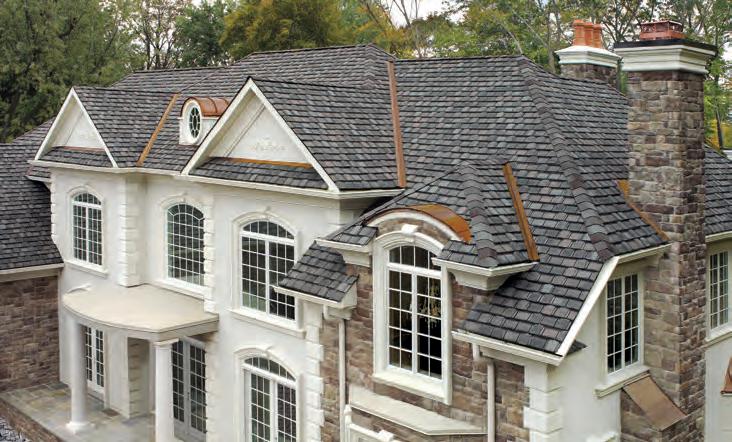


At Lyman Companies we specialize in what we know and love, which means we understand the roofing business inside and out. Our roofing specialists bring decades of experience to the table and are dedicated to getting material to you correctly and on time to keep your jobs moving.Whether your project is residential, commercial, or multi-family, we have the expertise, products, and services you need to get the job done right.


